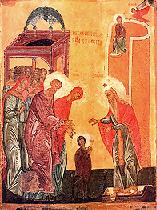|

Archbishop ANTHONY (Medvedev)
Milkovo Monastery of the Entrance into the Temple
(from the history of Russian monasticism abroad)
The Milkovo Monastery in Serbia was founded by St. King Stephen
in the beginning of the 15th century. He built the Manasia
Lavra with several sketes. One of these was Milkovo, at first
called Bukovici. Subsequently, Bukovici was restored by repentent
thieves named Milko and Todor. For the former, and from the
name of the pious Priest Milko, named Meletii after his tonsure,
came the name Milkovo.
In its time, the monastery was inspected by Bishop Benjamin
(Fedchenkov) of Sevastopol with the aim of establishing a
Russian monastery, but he preferred the better-established
and wealthier Petkovica.
The monastery is located at the foot of a mountain on the
shores of the Moravi River, near a railroad crossing at Lapovo.
The monastery is poor. A small church of the Entrance into
the Temple of the Most-Holy Mother of God has been rebuilt
in the middle of the last century, but the iconostasis is
of worm-eaten soft wood, which is already crumbling today.
The forest was cleared during the war, and a young forest
is growing. Actually, the Moravian land is very lush. Usually
2-3 Serbian monks live here. The most famous of these is the
abbott, Schema-Archimandrite Amvrosii (Kurganov), a "young
starets [elder]..."
Many old monks from Russian or Mt. Athos monasteries have
come here, the first of whom were a larger number of monks
from Valaam, driven out of their home monastery for their
rejection of the new calendar; then younger monks arrived...
In Milkovo, refraining from accusing your neighbor was deemed
a necessary good. In order to prevent accusations, Fr. Amvrosii
(Batushka) as an example taught monks to seek out the good
in every soul. For example, we have a hieromonk from Petkovici.
As a taylor, he sewed things without blessing for money to
private individuals. Batushka struggled against this evil,
and finally won him over, but to us he would say: "But,
you know, he is so chaste."
This attitude towards our weaknesses produced mutual love...
There was plenty of work in the monastery, but Batushka helped.
He would stop in on everyone, encourage them, advise them,
and occasionally would say to someone; "Look how good
we have it; it's a real monastery: Luke paints icons, Sergei
tends to the swine. Feofanushka makes candles, and Alyokha
bakes bread."
Batushka took upon himself two special obediences: to sing
the liturgy when others were busy, and make the monastery's
ovens.
For me the spirit of the Milkovo services were incomparable.
Batushka made us love these services and strove to participate
in them. For this, the baker, Fr. Stephen, arose at night,
in order to bake small cakes on holidays before liturgy and
make it in time to sing on the kliros, though no one required
this of him; for this the shepherd, Fr. Raphael, having herded
his flock, rushed to milk the cow and at least make it in
time for the middle of vigil. And an elderly Valaam monk,
accustomed to the services of the Valaam rule and who had
come to miss them, arriving in Milkovo would say, "Now
this is a monastery!"
Batushka sensed the Lord's beauty in the divine services,
in the singing, and especially in the old znamenny chant.
The Milkovo Monastery of the Entrance into the Temple of the
Most-Holy Mother of God was like Optina. Batushka fervently
tended to the glorification of the Mother of God in the Monastery.
After the end of morning and evening services, they sang the
troparion to the Entrance, and then went to the narthex and,
before the locally-venerated icon of the Heavenly Queen, sang
the endearing sticheron in the Valaam chant: "Do not
abandon me to the trials of mankind."
But to have seen the spiritual joy of Batushka, when he met
the holy icon of the Russian people, the Miracle-working Kursk-Root
Icon of the Most-Holy Mother of God! All-night vigil was begun
in time to be able to exit to the Moravi River after the first
kathisma. When the icon was carried in with the inspired singing
of the troparion, "Having attained thee as an unattainable
wall," and Batushka greeted the Icon with prostrations
and carried it into the church, performing a service of supplication
on the way.
The rebirth of Milkovo occurred circa 1931.
It should be noted that of the tonsured monks of Milkovo-Entrance
Monastery was Archbishop Tikhon of Western American and St.
John of Shanghai and San
Francisco the Miracle-worker of blessed memory.
From the article by Archbishop Anthony, "Young Starets."
|